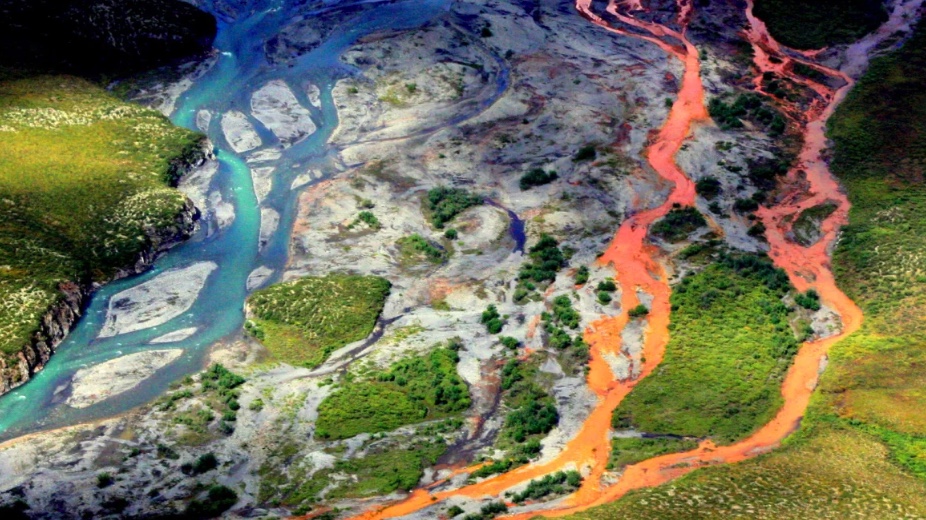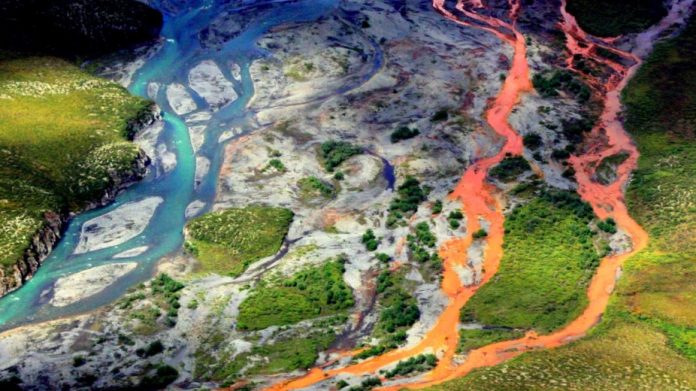การศึกษาใหม่เผยให้เห็นแม่น้ำและลำธารในอลาสก้าจากสีน้ำเงินใสเป็นสีส้มสนิมเนื่องจากโลหะพิษที่ปล่อยออกมาจากการละลายชั้นดินเยือกแข็งคงตัว นักวิจัยจากกรมอุทยานแห่งชาติ มหาวิทยาลัยแคลิฟอร์เนียที่เดวิส และสำนักงานสำรวจทางธรณีวิทยาของสหรัฐอเมริกาได้ทดสอบพื้นที่ 75 แห่งในเทือกเขาบรูคส์ (Brooks Range) ของอลาสก้าโดยพบว่าในช่วงห้าถึงสิบปีที่ผ่านมา ทางน้ำกลายเป็นสนิมและมีเมฆมาก การศึกษาที่เผยแพร่ใน Communications: Earth & Environment พบว่าโลหะ เช่น เหล็ก สังกะสี ทองแดง นิกเกิล และตะกั่ว ซึ่งถูกปล่อยออกมาจากการละลายของชั้นดินเยือกแข็งคงตัว ทำให้เกิดการเปลี่ยนสี โลหะเหล่านี้ซึ่งติดอยู่ใต้ดินเป็นเวลาหลายพันปี เป็นพิษต่อระบบนิเวศของแม่น้ำและลำธาร
รายงานการศึกษาระบุว่าดินอาร์กติกประกอบด้วยคาร์บอนอินทรีย์ สารอาหาร และโลหะ เช่น ปรอท ภายในชั้นดินเยือกแข็งคงตัว เมื่อชั้นดินเยือกแข็งคงตัวละลายเนื่องจากอุณหภูมิสูง แร่ธาตุเหล่านี้จะผสมกับแหล่งน้ำในบริเวณใกล้เคียง อาร์กติกอุ่นขึ้นเร็วกว่าค่าเฉลี่ยทั่วโลกถึง 4 เท่า และนักวิจัยใช้ภาพถ่ายดาวเทียมเพื่อตรวจสอบว่าแม่น้ำและลำธารเริ่มเปลี่ยนสีเมื่อใด การเปลี่ยนสีนี้เชื่อมโยงกับการลดลงอย่างมากของสิ่งมีชีวิตในน้ำ ทำให้เกิดความกังวลเกี่ยวกับผลกระทบต่อชุมชนที่ต้องอาศัยทางน้ำเหล่านี้เพื่อการดื่มและตกปลา แม่น้ำอาร์กติกของอลาสก้าเป็นที่อยู่อาศัยของปลาหลากหลายสายพันธุ์ที่มีความสำคัญต่อการยังชีพ การกีฬา และการประมงเชิงพาณิชย์ ชุมชนท้องถิ่นที่มีความกังวลเกี่ยวกับการเปลี่ยนแปลงเหล่านี้ได้เริ่มรายงานข้อสังเกตแก่นักวิจัยเมื่อเจ็ดปีที่แล้ว
อลาสก้าไม่ใช่รัฐเดียวที่ประสบปรากฏการณ์นี้ การศึกษาที่ตีพิมพ์เมื่อหนึ่งเดือนก่อนหน้านี้ในการวิจัยทรัพยากรน้ำ พบว่าผลกระทบที่คล้ายกันในเทือกเขาร็อกกี้ (Rocky Mountains) ของโคโลราโดเนื่องจากการเปลี่ยนแปลงสภาพภูมิอากาศ การศึกษาระบุความเข้มข้นที่เพิ่มขึ้นของโลหะ เช่น ซัลเฟต สังกะสี และทองแดงในลำธารบนภูเขา 22 แห่งในช่วง 30 ปีที่ผ่านมา นักวิจัยอ้างว่าสิ่งนี้เกิดจากกระแสน้ำที่ลดลงและการละลายพื้นที่น้ำแข็ง ซึ่งปล่อยแร่ธาตุออกจากพื้นหิน การศึกษานอกสหรัฐอเมริกา รวมถึงในเทือกเขาแอนดีสของชิลี (Andes) เทือกเขาแอลป์ของยุโรป (Alps) และพิเรนีส (Pyrenees) ยังรายงานถึงความเข้มข้นของโลหะที่เพิ่มขึ้นในแหล่งน้ำบนภูเขาด้วย แม้จะมีกิจกรรมการขุดในบางพื้นที่ แต่การค้นพบนี้ตอกย้ำความกังวลเกี่ยวกับผลกระทบของการเปลี่ยนแปลงสภาพภูมิอากาศต่อแหล่งน้ำสำคัญเหล่านี้ ในอลาสก้า การวิจัยที่กำลังดำเนินอยู่มีเป้าหมายเพื่อระบุแหล่งที่มาของโลหะและประเมินผลกระทบที่มีต่อชีวิตทางน้ำและชีวิตมนุษย์
Rivers and streams in Alaska are turning orange because of toxic metals in the water.

Rivers and streams in Alaska are turning from clear blue to rusty orange due to toxic metals released by thawing permafrost, a new study reveals. Researchers from the National Park Service, the University of California at Davis and the US Geological Survey tested 75 sites in Alaska’s Brooks Range, discovering that over the past five to ten years, the waterways have become rusty and cloudy. Published in Communications: Earth & Environment, the study found that metals like iron, zinc, copper, nickel, and lead, released as permafrost thaws, are causing the discoloration. These metals, trapped underground for thousands of years, are toxic to river and stream ecosystems.
Arctic soils naturally contain organic carbon, nutrients, and metals like mercury within their permafrost, the study reports. As permafrost melts due to high temperatures, these minerals mix with nearby water sources. The Arctic is warming four times faster than the global average, and researchers used satellite imagery to pinpoint when rivers and streams began changing colour. This discoloration is linked to significant declines in aquatic life, raising concerns about the impact on communities that rely on these waterways for drinking and fishing. Alaska’s Arctic rivers host various fish species vital for subsistence, sport, and commercial fisheries. Local communities, concerned about these changes, began reporting their observations to researchers seven years ago.
Alaska isn’t the only state experiencing this phenomenon. A study published a month earlier in Water Resources Research found similar effects in Colorado’s Rocky Mountains due to climate change. The study noted increased concentrations of metals like sulphate, zinc, and copper in 22 mountain streams over the past 30 years. Researchers attributed this to reduced streamflow and thawing frozen ground, which releases minerals from the bedrock. Studies beyond the US, including in the Chilean Andes, European Alps, and Pyrenees, also report rising metal concentrations in mountain waterways. Despite existing mining activities in some areas, the findings underscore concerns about climate change’s impact on these vital water sources. In Alaska, ongoing research aims to pinpoint metal sources and assess their effects on aquatic and human life.
By CNN NEWS

















